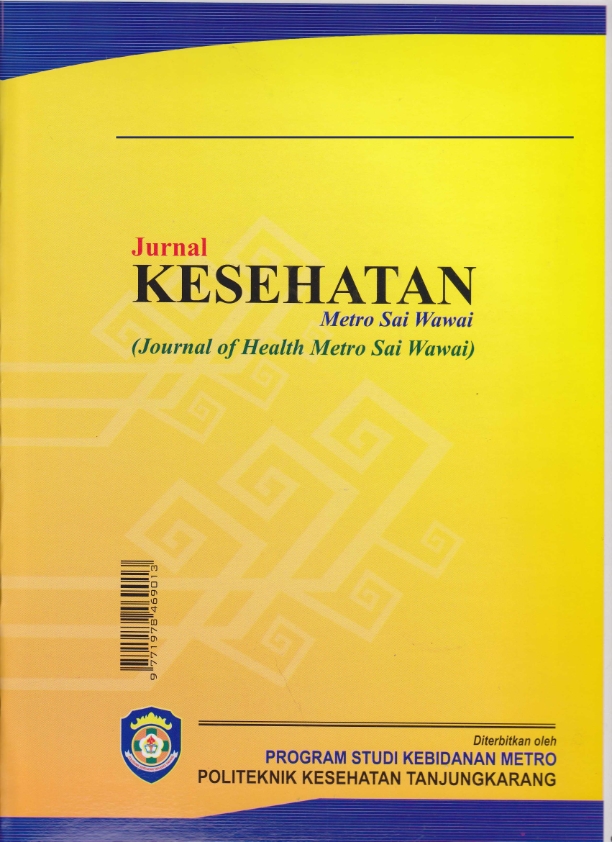Studies Literature: Connection Style Life with Incident Breast Cancer
DOI:
https://doi.org/10.26630/jkmsw.v17i2.4985Keywords:
Lifestyle, Incident breast cancer, Literature studiesAbstract
Introduction: Breast cancer is one of the non-communicable diseases that tends to continue to increase every year, so it can be said that the burden that the world has to bear due to the disease is increasing. Based on Globocan data in 2018 in Indonesia, breast cancer is in first place with the number of 16.7% cases, with the number of deaths as high as 11.0% matter This cannot be separated from the factors that trigger breast cancer, one of which is lifestyle. Objective: This literature review aims to determine the relationship between lifestyle, namely diet, physical activity, and exposure to cigarette smoke, with breast cancer. Methods: This study uses a literature review design. This study consists of 5 articles (3 national and 2 international) from 2005-2017. Data collection using literature studies obtained from Google Scholar and PubMed. From the research obtained, 3 literatures discuss cigarette smoke exposure variables, 3 literatures discuss smoking pattern variables, and 3 literatures discuss 3 variables of activity physique. Results: Data analysis was carried out by looking at the research year starting from the most recent and then stepping back to Which most long. From the literature obtained, 3 studies showed that there was a relationship between exposure to cigarette smoke and the incidence of breast cancer, 3 studies showed that there was a relationship between diet and the incidence of breast cancer, and 3 studies showed that there was a relationship between physical activity and incidence of breast cancer. Conclusion: There is a relationship between exposure to cigarette smoke, poor diet, and lack of physical activity with the incidence of breast cancer in women.
References
Barasi, M. E. (2010). Human nutrition: A health perspective (3rd ed.). London: Arnold Publishers.
Chiriac, V. F., Baban, A., & Dumitrascu, D. L. (2018). Psychological stress and breast cancer incidence: a systematic review. Clujul Medical, 91(1), 18. https://doi.org/10.15386/cjmed-924
Colditz, G. A., & Bohlke, K. (2015). Preventing breast cancer now by acting on what we already know. NPJ Breast Cancer, 1(1), 1-4. https://doi.org/10.1038/npjbcancer.2015.9
Dinas Kesehatan Kota Metro. (2019). Laporan cakupan skrining kanker payudara di 12 wilayah kerja Puskesmas Kota Metro tahun 2019. Kota Metro: Dinas Kesehatan Kota Metro.
Girsang, E., Siregar, R., & Simanjuntak, M. (2018). Hubungan konsumsi lemak dengan kejadian kanker payudara pada wanita. Jurnal Kesehatan Masyarakat, 9(2), 112–119.
Girsang, & suprapto, s. i. (2016). Patologi & Patofisiologi Penyakit. Yogyakarta: Nuha Medika.
Indrati, R. (2005). Faktor faktor risiko yang berpengaruh terhadap kejadian kanker payudara wanita. Jurnal Epidemiologi.
International Agency for Research on Cancer. (2019). GLOBOCAN 2018: Global cancer statistics for 2018. World Health Organization. Retrieved from https://gco.iarc.fr/
Kementerian Kesehatan Republik Indonesia. (2019). Riskesdas 2018: Riset Kesehatan Dasar. Jakarta: Kementerian Kesehatan RI.
Lope, V., Martín, M., Castelló, A., Casla, S., Ruiz, A., Baena-Cañada, J. M., ... & behalf of GEICAM, O. (2017). Physical activity and breast cancer risk by pathological subtype. Gynecologic oncology, 144(3), 577-585. https://doi.org/10.1016/j.ygyno.2016.12.014
Maria, I. L., Sainal, A. A., & Nyorong, M. (2017). Risiko gaya hidup terhadap kejadian kanker payudara pada wanita. Media Kesehatan Masyarakat Indonesia, 13(2), 157.
Mangan, Y. (2007). Cara Bijak Menaklukan Kanker. Jakarta: Agromedia Pustaka.
Manik, N. T., Maryati, I., & Ermiati. (2012). Riwayat Gaya Hidup Penderita Kanker Payudara.
Jakarta.
Medforth, J., Battersby, S., Evans, M., B., & Walker, A. (2015). Kebidanan Oxford dari Kebidanan Untuk Bidan. Jakarta: Buku Kedokteran.
Mulyani, N. S., & Rinawati, M. (2013). Kanker Payudara dan PMS pada Kehamilan. Yogyakarta: Nuha Medika.
Mulyasari, A. D., Hartati, B., & Cece, S. (2017). Analisis Faktor Risiko Kanker Payudara pada RSU. BahteraMas Kota Kendari Provinsi Sulawesi Tenggara Tahun 2017. Jurnal Ilmiah Mahasiswa Kesehatan Masyarakat, 2(6).
Suardita, I. W., Chrisnawati, C., & Agustina, D. M. (2016). Faktor-Faktor Resiko Pencetus Prevalensi Kanker Payudara. Jurnal Keperawatan Suaka Insan (JKSI), 1(2), 1-14. https://doi.org/10.51143/jksi.v1i2.40
Sudewo, B. (2012). Basmi Kanker Dengan Herbal. Jakarta: Visimedia.
Sugiyono. (2018). Metode Penelitian Kuantitatif, Kualitatif dan R&D. Bandung: Alfabeta. Sukmana, T. (2011). Mengenal Rokok dan Bahayanya. Jakarta: Be Champion.
Sun, Y. S., Zhao, Z., Yang, Z. N., Xu, F., Lu, H. J., Zhu, Z. Y., ... & Zhu, H. P. (2017). Risk factors and preventions of breast cancer. International journal of biological sciences, 13(11), 1387. 10.7150/ijbs.21635
Tapan, d. (2005). Kanker, Antioksidan dan Terapi Komplementer. Jakarta: Gramedia.
WHO. (2012). Global Physical Activity Surveillance. World Health Organizatoin:
http://www.who.int/ncds/surveillance/steps/GPAQ/en/
Xue, F., Willett, W. C., Rosner, B. A., Hankinson, S. E., & Michels, K. B. (2011). Cigarette smoking and the incidence of breast cancer. Archives of internal medicine, 171(2), 125-133. https://doi.org/10.1001/archinternmed.2010.503
Yulianti, I., Santoso, H. S., & Sutinigsih, D. (2016). Faktor-faktor risiko kanker payudara (studi kasus pada Rumah Sakit Ken Saras Semarang). Jurnal Kesehatan Masyarakat, 4(4), 401- 409. https://doi.org/10.14710/jkm.v4i4.14162
Downloads
Published
Issue
Section
License
Copyright (c) 2024 Ria Ayu Marvina

This work is licensed under a Creative Commons Attribution-NonCommercial 4.0 International License.

Jurnal Kesehatan Metro Sai Wawai is licensed under a Creative Commons Attribution-NonCommercial 4.0 International License.






